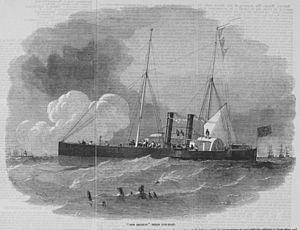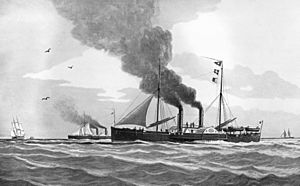SMS Salamander (1850) facts for kids

Recruit in action at Taganrog on 3 June 1855, Illustrated London News. by Edwin Weedon
|
|
Quick facts for kids History |
|
|---|---|
| Name | Salamander |
| Namesake | Salamander |
| Builder | Robinson & Russell |
| Laid down | 1850 |
| Launched | 1850 |
| Commissioned | 1 July 1851 |
| Fate | Sold to Britain, 12 January 1855 |
| Name | Recruit |
| Acquired | 12 January 1855 |
| Fate | Sold in January 1870 |
| Name | Recruit |
| Owner |
|
| Acquired | January 1870 |
| Identification | Official Number 63244 |
| Fate | by 1878 a powder magazine |
| General characteristics | |
| Class and type | Nix-class aviso |
| Displacement | |
| Length | 53.85 m (176 ft 8 in) o/a |
| Beam |
|
| Draft | 2 m (6 ft 7 in) |
| Installed power | |
| Propulsion |
|
| Speed | 13 kn (24 km/h; 15 mph) |
| Range | 2,500 nmi (4,600 km; 2,900 mi) at 10 kn (19 km/h; 12 mph) |
| Complement |
|
| Armament | 4 × 25-pound mortars |
The SMS Salamander was a special type of ship called an aviso, built for the Prussian Navy in the early 1850s. It was the second and last ship of its kind, known as the Nix class class. Even though it was built for the Prussian Navy, it didn't see much action, mostly just a few training exercises.
In 1855, the ship was sold to the British Royal Navy. It was part of a trade for a sailing ship called Thetis. When it joined the British fleet, its name was changed to HMS Recruit. After this, it was sent to the Black Sea during the Crimean War. Here, it helped with missions to disrupt Russian supplies. However, the Royal Navy didn't use the ship much either. It stayed mostly inactive in Valletta, Malta, until late 1861. The only notable events during this time were in 1857 when it helped rescue a gunboat and two merchant ships that had gotten stuck. Recruit was sent back to Britain in late 1861 and stayed in storage until 1869. In the 1870s, it became a merchant ship and was later used to store gunpowder in Cape Town.
Contents
Ship Design and Features
The Nix-class avisos were paddle steamers. This means they used large wheels on their sides, powered by steam engines, to move through the water. These ships were designed in 1849 by a British naval architect named John Scott Russell and Prince Adalbert of Prussia. They were ordered in 1850 to help make the small Prussian Navy stronger during the First Schleswig War.
The Salamander was about 53.85 m (176 ft 8 in) long. Its main body was 7.2 m (23 ft 7 in) wide, but with the paddle wheels, it was much wider at 12.4 m (40 ft 8 in). The ship sat about 2 m (6 ft 7 in) deep in the water. It had two steam engines that powered its paddle wheels. Four boilers created the steam for these engines, and the smoke went out through two funnels. The ship could reach a top speed of 13 kn (24 km/h; 15 mph) (about 24 kilometers per hour). It could travel about 2,500 nmi (4,600 km; 2,900 mi) (around 4,630 kilometers) at a speed of 10 kn (19 km/h; 12 mph). The crew included about four officers and seventy other sailors. For defense, it carried four 25-pound mortars, which are like small cannons that fire shells in a high arc.
Life of the Ship
As SMS Salamander
The building of Salamander started in 1850, and it was launched later that same year. Its name came from the amphibian. There was a rush to finish Salamander before the Baltic Sea ports froze over for winter. So, work on its sister ship Nix was paused to focus on Salamander.
Initial tests of the ship began in December 1850. These tests went well, and the ship was taken to Swinemünde. After some discussions about taxes on the ship's equipment, it was moved to a naval base in Stettin and put into storage.
In April 1851, Salamander was brought back into service to help its sister ship Nix, which had gotten stuck near Stettin. On July 1, 1851, Salamander officially joined the fleet for training. The King, Friedrich Wilhelm IV, even took a trip on the ship in July. The ship was then put back into storage in September.
It was used again on June 11, 1853, to travel to Sweden for repairs. Later that year, it took part in training and carried King Friedrich Wilhelm IV to an island. However, it had to return to port on September 17 because some of the crew became sick with cholera. The ship remained out of service until May 1854, when it was moved to Danzig.
Salamander was put into service one last time for Prussia on October 22, 1854. The plan was to take it and Nix to Britain to trade them for a British frigate called Thetis. The Prussian Navy decided to sell these two ships because they had a bad reputation, especially Nix, which had several fires related to its boilers. The British needed small, fast steamships for the Crimean War, so the trade was a good deal for both sides.
In November, Nix and Salamander left Danzig. They stopped in Jade Bay for celebrations before continuing their journey to Britain. After some difficulty getting permission to refuel in Bremen, they finally reached Britain in December.
As HMS Recruit

On January 12, 1855, the ship officially became British property and was renamed HMS Recruit. After some repairs, it was sent to the Mediterranean Fleet and joined the British and French ships fighting in the Black Sea during the Crimean War.
On May 25, Recruit and other ships entered the Sea of Azov. Over the next four days, they captured or destroyed about 245 ships that were carrying supplies for Russian forces. They also destroyed supply areas in towns like Berdiansk, Genitchi, and Taganrog.

After the war, Recruit was stationed in Valletta, Malta, and didn't do much until October 1861. During this time, it helped rescue a gunboat called HMS Cracker in January 1857, which had broken free and run aground. In August, it helped another British ship, Gazelle, which had gotten stuck near Patras, Greece. On December 12, it helped a third British ship, Cynthia, which had run aground at Missolonghi, Greece. Recruit was ordered back to Britain in October 1861 for major repairs, but instead, it was simply put into storage until it was sold.
Later Life and Sale
On September 23, 1869, Recruit was put up for sale but didn't find a buyer. In January 1870, it was finally sold to Edward Bates, a businessman from Liverpool. He registered it as a merchant ship, still named Recruit. In April of that year, the ship sailed to South America, arriving in Montevideo in November. Later, the ship was in Cape Town. By 1874, it was owned by the Table Bay Dock & Breakwater Management Commission. By 1878, it was being used as a powder magazine, a safe place to store gunpowder.


